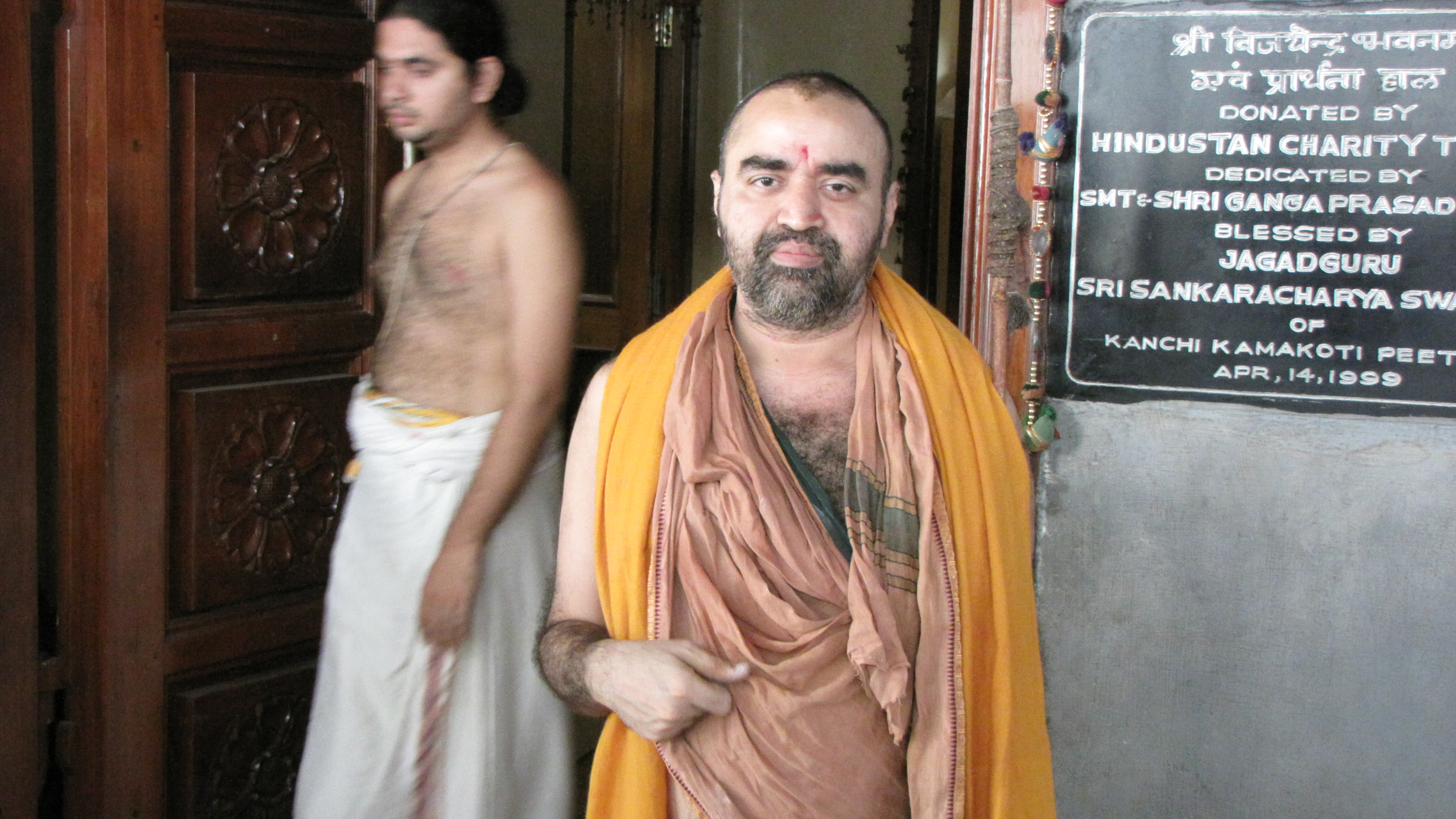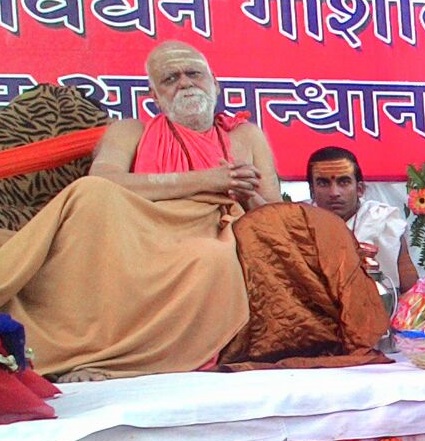|
Shankaracharya
Shankaracharya ( sa, शङ्कराचार्य, , "Adi Shankara, Shankara-''acharya''") is a religious title used by the heads of amnaya monasteries called mathas in the Advaita Vedanta tradition of Hinduism. The title derives from Adi Shankara; teachers from the successive line of teachers retrospectively dated back to him are known as Shankaracharyas. Establishment of the tradition According to a tradition developed in the 16th century, Adi Shankara set up four monasteries known as Mathas or Peethams, in the North, South, East and West of India, to be held by realised men who would be known as Shankaracharyas. They would take on the role of teacher and could be consulted by anyone with sincere queries of a spiritual nature. Another monastery Kanchi Kamakoti Peetham, Kanchi Kamkoti Peeth in south India also derives its establishment and tradition to Adi Shankara, however its heads are called "Acharya" or "Jagadguru" instead of "Shankaracharya". The table below gives ... [...More Info...] [...Related Items...] OR: [Wikipedia] [Google] [Baidu] |
Jyotir Math
Uttarāmnāya Śrī Jyotish Pītham or Jyotir Math is one amongst the four cardinal pīthams established by the 820 CE philosopher-saint Śrī Ādi Śaṅkara to preserve and propagate Sanātana Dharma and Advaita Vedānta, the doctrine of non-dualism. Located in the city of Joshimath, Chamoli district, Uttarakhand, India, it is the uttarāmnāya ''matha'' or Northern Āmnāya Pītham, amongst the four Chaturamnaya Peethams, with the others being the Sringeri Śārada Pīṭhaṃ (Karnataka) in the South, Dvārakā Śāradā Pītham (Gujarat) in the West, and Purī Govardhanmaṭha Pīṭhaṃ (Odisha) in the East. Its appointees bear the title of Shankaracharya. It is the headquarters of Giri, Parvata & Sagara sects of the Dasnami Sampradaya (monistic order). Their Vedantic mantra or Mahavakya is ''Ayamātmānam brahma (This Atman is supreme being) and'' as per the tradition initiated by Adi Shankara it holds authority over Atharva Veda. The head of the matha is called ... [...More Info...] [...Related Items...] OR: [Wikipedia] [Google] [Baidu] |
Adi Shankara
Adi Shankara ("first Shankara," to distinguish him from other Shankaras)(8th cent. CE), also called Adi Shankaracharya ( sa, आदि शङ्कर, आदि शङ्कराचार्य, Ādi Śaṅkarācāryaḥ, lit=First Shankaracharya, ), was an Indian Vedic scholar and teacher (''acharya''), whose works present a harmonizing reading of the ''sastras'', with liberating knowledge of the self at its core, synthesizing the Advaita Vedanta teachings of his time. The title of Shankracharya, used by heads of the amnaya monasteries is derived from his name. Due to his later fame, over 300 texts are attributed to his name, including commentaries (''Bhāṣya''), introductory topical expositions (''Prakaraṇa grantha'') and poetry (''Stotra''). However most of these are likely to be by admirers or pretenders or scholars with an eponymous name.W Halbfass (1983), Studies in Kumarila and Sankara, Studien zur Indologie und Iranistik, Monographic 9, Reinbeck Works known ... [...More Info...] [...Related Items...] OR: [Wikipedia] [Google] [Baidu] |
Sringeri Sharada Peetham
Dakṣināmnāya Śrī Śāradā Pītham or Śri Śringeri Maṭha (, ; sa, मठ, ) is one amongst the four cardinal pīthams following the Daśanāmi Sampradaya - the ''peetham'' or ''matha'' is said to have been established by acharya Śrī Ādi Śaṅkara to preserve and propagate Sanātana Dharma and Advaita Vedānta, the doctrine of non-dualism. Located in Śringerī in Chikmagalur district in Karnataka, India, it is the Southern Āmnāya Pītham amongst the four Chaturāmnāya Pīthams, with the others being the Dvārakā Śāradā Pītham (Gujarat) in the West, Purī Govardhana Pīṭhaṃ (Odisha) in the East and Badri Jyotishpīṭhaṃ (Uttarakhand) in the North. The head of the matha is called Shankarayacharya, the title derives from Adi Shankara. Śri Śringerī Mutt, as the Pītham is referred to in common parlance, is situated on the banks of the Tuṅgā River in Śringerī. The Mutt complex consists of shrines on both the northern and southern banks ... [...More Info...] [...Related Items...] OR: [Wikipedia] [Google] [Baidu] |
Kanchi Kamakoti Peetham
Sri Kanchi Kamakoti Peetham, also called the Sri Kanchi Matham or the Sri Kanchi Monastery or the Sarvagna Peetha, is a Hindu institution, located in Kanchipuram, Tamil Nadu. It is located near a temple dedicated to Goddess Sri Kamakshi (Durga, Kamakoti, Maha Tripurasundari) of the Shaktism tradition, along with a shrine for the Advaita Vedanta teacher Adi Shankara. The matha-tradition attributes its founding to Adi Shankara, but this and the reliability of the matha's succession list has been questioned. The Kanchi Math was originally established as the Kumbakonam Mutt in 1821 as a branch of the Sringeri Mutt, and later became involved with the Kamakshi temple in Kanchipuram. According to the Sri Kanchi math tradition, the matha was founded at Kanchipuram, and shifted south to the temple city of Kumbakonam in mid-18th-century due to the on-going wars, when there was warfare in the region, and returned to Kanchipuram in the 19th century. The matha is a living tradition, ... [...More Info...] [...Related Items...] OR: [Wikipedia] [Google] [Baidu] |
Dwarka Sharada Peetham
Pascimāmnāya Śrī Śāradā Pītham or Dwarka Sharada Math, is one amongst the four cardinal peethams established by the saint Adi Shankara to preserve and propagate Sanatana Dharma and Advaita Vedanta, the doctrine of non-dualism. Located in the city of Dwaraka, Gujarat, India it is the ''pascimāmnāya matha'', or Western Āmnāya PīthamPasricha, Prem C. (1977) The Whole Thing the Real Thing, Delhi Photo Company, p. 59-63 amongst the four Chaturāmnāya Pīthams, with the others being the Sringeri Śāradā pīṭhaṃ (Karnataka) in the South, Purī Govardhanmaṭha Pīṭhaṃ (Odisha) in the East and Badari Jyotirmaṭha Pīṭhaṃ (Uttarakhand) in the North. It is also known as the Kālikā Matha. Their Vedantic mantra or Mahavakya is ''Tattvamasi (That thou art) and'' as per the tradition initiated by Adi Shankara it holds authority over Sama Veda. The head of the matha is called Shankarayacharya, the title derives from Adi Shankara. History # Shri Trivikrama T ... [...More Info...] [...Related Items...] OR: [Wikipedia] [Google] [Baidu] |
Govardhan Math
Purvamnaya Sri Govardhana Peetham or Govardhan Math is one amongst the four cardinal peethams established by the philosopher-saint Bhagwan Adi Shankaracharya to preserve and propagate Sanatana Dharma and Advaita Vedanta, the doctrine of non-dualism. Located in Puri in Odisha, India, it is the Eastern Āmnāya Pītham amongst the four Chaturamnaya Peethams, with the others being the Sringeri Śārada Pīṭhaṃ (Karnataka) in the South, Dvārakā Śāradā Pītham (Gujarat) in the West, and Badari Jyotirmaṭha Pīṭhaṃ (Uttarakhand) in the North. It is associated with the Jagannath temple. Their Vedantic mantra or Mahavakya is ''Prajñānam brahma (Consciousness is supreme being) and'' as per the tradition initiated by Adi Shankara it holds authority over Rig Veda. The head of the matha is called Shankarayacharya, the title derives from Adi Shankara. The deities here are Jagannath (Lord Vishnu) and the devi is Vimala (Bhairavi). There are Shri Vigrahas of ''Govardhana ... [...More Info...] [...Related Items...] OR: [Wikipedia] [Google] [Baidu] |
Nischalananda Saraswati
Nischalananda Saraswati is the current 145th Jagadguru Shankaracharya of the Purvamnaya Sri Govardhana Peetham of Puri, Odisha, India. He is also a mathematician who has published over 200 books on the subject. Life Niscalananda Saraswati was born in Madhubani in 1943, the son of the raj-Pandita of Maharaja of Darabhanga. See also *Advaita Vedanta *Adi Shankara *Smartism The ''Smarta'' tradition ( sa, स्मार्त), also called Smartism, is a movement in Hinduism that developed and expanded with the Puranas genre of literature. It reflects a synthesis of four philosophical strands, namely Mimamsa, A ... References External linksPurvamnaya Sri Govardhana Peetham Advaita Ved ... [...More Info...] [...Related Items...] OR: [Wikipedia] [Google] [Baidu] |
Bharathi Tirtha
Bharathi Tirtha Mahaswamiji (alternative spellings: Bharati, Teertha), real name Seetharama Anjaneyalu (born 11 April 1951), is an Indian religious leader who is the current and 36th Shankaracharya of Sringeri Sharada Peetham, an important Hindu monastery in the tradition of Advaita Vedanta established by Sri Adi Shankara. Early life and career Bharathi Tirtha was born 11 April 1951 to a Telugu Smarta family from Machilipatnam. His family later moved to Narasaraopet, Andhra Pradesh. He was a religiously-minded child. His ''upanayana'' ceremony was performed when he was seven years of age. In addition to schooling, he spent his time studying Sanskrit and took lessons in the Vedas from his father who himself was a Vedic scholar. In the year 1966, at the age of 15, Anjaneyalu approached the 35th Jagadguru of the Sringeri Sharada Peetham, Abhinava Vidyatirtha, seeking religious guidance from him. Vidyatirtha accepted Anjaneyalu as the disciple. Abhinava Vidyatirtha appointed ... [...More Info...] [...Related Items...] OR: [Wikipedia] [Google] [Baidu] |
Advaita Vedanta
''Advaita Vedanta'' (; sa, अद्वैत वेदान्त, ) is a Hinduism, Hindu sādhanā, a path of spiritual discipline and experience, and the oldest extant tradition of the Āstika and nāstika, orthodox Hindu school Vedanta, Vedānta. The term ''Advaita'' (literally "non-secondness", but usually rendered as "nondualism", and often equated with monism) refers to the idea that ''Brahman'' alone is ultimately Satya, real, while the transient phenomenon (philosophy), phenomenal world is an illusory appearance (''Maya (religion), maya'') of Brahman. In this view, (''jiv)Ātman (Hinduism), Ātman'', the experiencing self, and ''Ātman-Brahman'', the highest Self and ultimate Reality, Absolute Reality, is non-different. The ''jivatman'' or individual self is a mere reflection or limitation of singular ''Ātman'' in a multitude of apparent individual bodies. In the Advaita tradition, ''moksha'' (liberation from suffering and rebirth) is attained through recogni ... [...More Info...] [...Related Items...] OR: [Wikipedia] [Google] [Baidu] |







